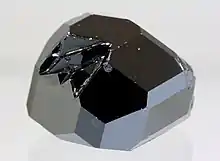| Yttrium iron garnet | |
|---|---|
 | |
| General | |
| Category | Synthetic mineral |
| Formula (repeating unit) | Y3Fe2(FeO4)3 or Y3Fe5O12 |
| Identification | |
| Formula mass | 737.94[1] |
| Color | Green[1] |
| Density | 5.11 g/cm3[1] |
| Other characteristics | Ferrimagnetic material |
Yttrium iron garnet (YIG) is a kind of synthetic garnet, with chemical composition Y3Fe2(FeO4)3, or Y3Fe5O12. It is a ferrimagnetic material[1] with a Curie temperature of 560 K.[2] YIG may also be known as yttrium ferrite garnet, or as iron yttrium oxide or yttrium iron oxide, the latter two names usually associated with powdered forms.[3]
In YIG, the five iron(III) ions occupy two octahedral and three tetrahedral sites, with the yttrium(III) ions coordinated by eight oxygen ions in an irregular cube. The iron ions in the two coordination sites exhibit different spins, resulting in magnetic behavior.[2] By substituting specific sites with rare-earth elements, for example, interesting magnetic properties can be obtained.[4]
YIG has a high Verdet constant which results in the Faraday effect,[5][6] high Q factor in microwave frequencies,[7] low absorption of infrared wavelengths down to 1200 nm,[8] and very small linewidth in electron spin resonance. These properties make it useful for MOI (magneto optical imaging) applications in superconductors.[9]
YIG is used in microwave, acoustic, optical, and magneto-optical applications, e.g. microwave YIG filters, or acoustic transmitters and transducers.[10] It is transparent for light wavelengths over 600 nm — the infrared end of the spectrum. It also finds use in solid-state lasers in Faraday rotators, in data storage, and in various nonlinear optics applications.[11]
See also
References
- 1 2 3 4 "Yttrium Iron Garnet - YIG". American Elements. Retrieved April 1, 2015.
- 1 2 Vladimir Cherepanov; Igor Kolokolov & Victor L'Vov (1993). "The Saga of YIG: Spectra, Thermodynamics, Interaction and Relaxation of Magnons in a Complex Magnet". Physics Reports. 229 (3): 84–144. Bibcode:1993PhR...229...81C. doi:10.1016/0370-1573(93)90107-o.
- ↑ "Yttrium Iron Oxide / Yttrium Ferrite (Y3Fe5O12) Nanoparticles – Properties, Applications". AZoNano.com. September 10, 2013. Retrieved April 1, 2015.
- ↑ J Goulon; A Rogalev; F Wilhelm; G Goujon; A Yaresko; Ch Brouder & J Ben Youssef (2012). "Site-selective couplings in x-ray-detected magnetic resonance spectra of rare-earth-substituted yttrium iron garnets". New Journal of Physics. 14 (6): 063001. Bibcode:2012NJPh...14f3001G. doi:10.1088/1367-2630/14/6/063001.
- ↑ Vojna, David; Slezák, Ondřej; Yasuhara, Ryo; Furuse, Hiroaki; Lucianetti, Antonio; Mocek, Tomáš (2020). "Faraday Rotation of Dy2O3, CeF3 and Y3Fe5O12 at the Mid-Infrared Wavelengths". Materials. 13 (23): 5324. Bibcode:2020Mate...13.5324V. doi:10.3390/ma13235324. PMC 7727863. PMID 33255447.
- ↑ K.T.V. Grattan; B.T. Meggitt, eds. (1999). Optical Fiber Sensor Technology: Volume 3: Applications and Systems. Springer Science & Business Media. pp. 214–215. ISBN 9780412825705. Retrieved April 2, 2015.
- ↑ Leonid Alekseevich Belov; Sergey M. Smolskiy & Viktor Neofidovich Kochemasov (2012). Handbook of RF, Microwave, and Millimeter-wave Components. Artech House. p. 150. ISBN 9780412825705. Retrieved April 2, 2015.
- ↑ Rajpal S. Sirohi (1990). Optical Components, Systems and Measurement Techniques. CRC Press. p. 80. ISBN 9780824783952. Retrieved April 2, 2015.
- ↑ "Magneto-Optical Imaging of Superconductors". Department of Physics, University of Oslo. November 30, 2010. Archived from the original on June 24, 2019. Retrieved April 2, 2015.
- ↑ "Periodic Table of Elements: Yttrium". Los Alamos National Laboratory. Retrieved April 1, 2015.
- ↑ Holm, U., Sohlstrom, H., & Brogardh, T. (1984). "YIG-Sensor Design for Fiber Optical Magnetic-Field Measurements". Proceedings of the Society of Photo-Optical Instrumentation Engineers, 514, 333–336.